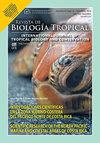危地马拉安的列斯海牛线粒体DNA控制区单倍型的初步鉴定
IF 0.6
4区 生物学
Q4 BIOLOGY
引用次数: 0
摘要
导言:小种群比大种群更容易丧失遗传变异;这随后降低了它们在面对环境变化时的适应能力。在危地马拉发现了濒临灭绝的安的列斯海牛(trichecchus manatus manatus)的一小群。目的:通过分析危地马拉安的列斯海牛两个最重要栖息地(Bahía La Graciosa沿海海湾和Bocas del Polochic沿海湿地)的线粒体DNA控制区单倍型,探讨安的列斯海牛的遗传多样性。方法:采用无创或微创取样技术采集遗传样本:刮表皮组织、收集浮粪、收集尸体组织。采用DNA提取、PCR扩增和对照d环区测序对样品进行处理和分析。 结果:从采集的36个样本(最少4个,最多7个)中获得7个线粒体DNA序列。4个单倍型分别为A01、A03、A04和J01。没有其他中美洲国家在海牛种群中报道过如此数量的单倍型,这是该地区首次报道A01单倍型。危地马拉海牛种群包括至少两个遗传谱系,佛罗里达/大安的列斯谱系(单倍型A01, A03和A04)和中美洲谱系(J01)。结论:有必要使用核标记进行进一步的研究,以了解Bahia La Graciosa和Bocas del Polochic之间的种群动态,以确定该国存在的管理单位的数量;此外,需要确定与伯利兹人口的亲缘关系程度,以便更好地协调保护工作。本文章由计算机程序翻译,如有差异,请以英文原文为准。
Initial characterization of mitochondrial DNA control region haplotypes of the Antillean manatee (Trichechus manatus manatus, Sirenia:Trichechidae) in Guatemala
Introduction: Small populations are at risk of losing genetic variability much faster than large populations; this subsequently decreases their ability to adapt when facing environmental changes. A small population of the endangered Antillean manatee (Trichechus manatus manatus) has been identified in Guatemala.
Objective: This study explored the genetic diversity of the Antillean manatee in Guatemala by analysing mitochondrial DNA control region haplotypes in the two most important habitats for the species, Bahía La Graciosa, a coastal bay and Bocas del Polochic, a coastal wetland, both located in the Izabal State.
Methods: Genetic samples were collected using non or minimally invasive sampling techniques: scraping of epidermal tissue, collection of floating feces, and collection of tissue from carcasses. DNA extractions, DNA amplification using polymerase chain reaction (PCR), and sequencing of the control D-loop region were used to process and analyse the samples.
Results: Seven mitochondrial DNA sequences were obtained from 36 samples collected (minimum of four and maximum of seven individuals). Four haplotypes were identified, A01, A03, A04, and J01. No other Central American country has reported this number of haplotypes in a manatee population, and it is the first time that haplotype A01 has been reported for the region. The Guatemalan manatee population comprises at least two genetic lineages, the Florida/Greater Antilles lineage (haplotypes A01, A03, and A04) and the Mesoamerican lineage (J01).
Conclusion: Further studies, with the use of nuclear markers, are necessary to understand the population dynamics between Bahia La Graciosa and Bocas del Polochic to identify the number of management units present in the country; also, the degree of relatedness with the Belizean population needs to be established to better coordinate conservation efforts.
求助全文
通过发布文献求助,成功后即可免费获取论文全文。
去求助
来源期刊

Revista De Biologia Tropical
生物-生物学
CiteScore
1.80
自引率
0.00%
发文量
23
审稿时长
4-8 weeks
期刊介绍:
The Revista de Biología Tropical / International Journal of Tropical Biology and Conservation is a mainstream scientific journal published since 1953 and covered by Web of Science; Science Citation Index; Current Contents; Google Scholar; Scopus, SciELO and nearly 50 additional indices.
A double blind system guarantees you a fair evaluation, and our world class editorial and scientific boards provides a first decision in three working days. The journal is Full Open Access and is widely read where your article can have the highest real impact.
Since its beginning in 1953, the Revista follows these principles: objective and independent evaluation of all manuscripts; transparency in all processes; ethical use of procedures, data, specimens and subjects; fair treatment of all parties; and absolute predominance of scientific rigor over any other aspect.
 求助内容:
求助内容: 应助结果提醒方式:
应助结果提醒方式:


